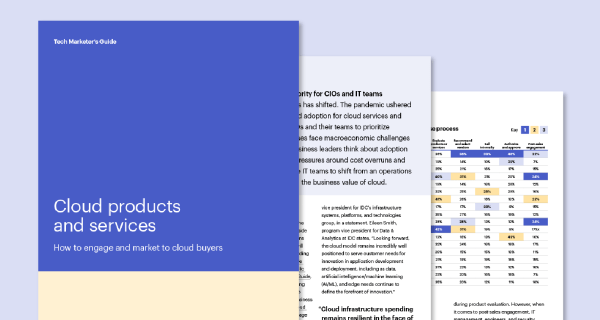Robots aren’t coming for your job, but they are meddling with brand trust
The next 2-3 years look to be a remarkable transition in B2B marketing that will define the discipline for a decade or more.
Of course, the last 12 months have seen no shortage of gloomy takes on the outlook for B2B marketers. Marketing budgets prioritize tech over people, even though CMOs say their current tech is under-utilized. Gen AI automates marketing’s creative and analytical work at a low cost. Regulatory changes continue to disrupt traditional targeting methods. And buyers — they’re more reluctant to engage brands directly than ever early in their journey.
But with all due respect to the naysayers, here are 3 things that I believe spell opportunity for B2B marketers who want a chance to lead from the front — and a few suggestions on how to get started.
AI will fundamentally change how brands build trust with prospects
#1: Search interfaces inspired by ChatGPT will gradually intermediate your brand and your audience’s consumption of your digital content
The explosion in B2B content marketing 20 years ago was driven by the value companies derived from creating a “digital breadcrumb” trail to buyers.
That strategy yielded diminishing returns as buyers responded with less enthusiasm to trade personal information for digital content. In response, brands “ungated” much content and learned to rely instead on intent data that picked up digital breadcrumbs anonymously at the company level.
Now buyers are on the cusp of simplifying their research even more — this time by having ChatGPT-derived interfaces — I’ll call it “Search AI” here — answer their queries, instead of manually navigating and synthesizing information from a dozen search results.
But that shift means that even when prospects are benefiting from your content, they won’t know it.
#2: The weakened connection between brands and buyers around digital content will diminish the value of traditional content marketing
To state the obvious, there are at least two key motivations driving B2B content marketing today:
- Creating a trusted relationship with your audience, and
- Generating digital breadcrumbs that focus your budget on the best prospects
Will generative AI help you to publish thought leadership content at unheard-of volumes and quality levels? Perhaps. But doing so will be of precious little benefit if that content is (a) consumed in a way that hides your brand from the buyer and (b) generates no digital breadcrumbs from prospects. i.e., through Search AI. As that shift occurs B2B marketers will have to think differently about top-of-funnel engagement. If digital content can no longer build trusted relationships with early-stage prospects, what can?
#3: The winners in this coming era will be the marketers who innovate ways to build trusted relationships with prospects that Search AI can’t disrupt
The job of B2B marketing will continue to be building trusted relationships with ideal prospects so that sales can engage and convert them into customers — but the assets at the heart of their work will have to change. To use a parallel: over the last decade, B2B marketers have become expert at turning insights from customer success reps, data teams, and other Subject Matter Experts (SMEs) into “thought leadership.” As we’ve illustrated here, that strategy will yield diminishing returns — so what is the new SME, the company asset that marketers work to cultivate, amplify, and externalize to attract and engage early-stage prospects?
I’ll suggest a few possibilities.
Building trust in the era of search AI
Your product as your content
There’s an obvious candidate when you ask, “What brand asset do we have that Search AI can’t mediate to my audience?”
Your product.
Not the entire thing — this isn’t a pitch for all companies to consider Product Led Growth (PLG) — but rather discrete Product Experiences narrowly designed to address top-of-funnel concerns your prospects have. Where marketing needs to lead in their companies is imagining what those product experiences can be (mapping value to the buyer’s journey) and forming new collaborative relationships with Product Management to deliver them.
At Foundry, the marketing team did this for their intent data product by launching Intent Bot — a tool to help early-stage buyers understand what intent data was and how to use it, delivered through a lightweight product experience rather than a content asset. Intent Bot offers personalized intent data specific to the user’s query, allowing users to understand the benefits upfront and before entering their email addresses.

Yes, this involved uncomfortable new partnerships between marketing and product management. Yes, it involved tradeoffs between shipping features in the roadmap. But that’s no less valid a tradeoff than when we take an SME and have them write marketing content instead of helping a customer solve a problem.
Your community as your content
If hands-on product experience is the best trust-builder with prospects, a close second is interacting with your most successful customers.
Many companies already have strong efforts underway in this area, such as generating positive customer reviews to post on product review websites. Another tactic is to incentivize customers to spread positive word of mouth on other channels, like Chili Piper’s ‘Chili Champions’ initiative. That said — those efforts are susceptible to mediation by Search AI just as other digital content is, so to really protect and project your customers’ voice, marketers will need to deliver true human-to-human interactions between customers and prospects.
That type of community marketing offers potential customers a unique opportunity to connect with existing users, ask questions, and truly grasp the value of your product — and offers strong early returns in exchange. Before purchasing a product, 27% of potential customers use dedicated brand communities to research the product. These communities, such as the CIO’s Executive Council Community, play a pivotal role in building trust and relationships that can span individuals’ careers across many companies.
Your pilot as your content
While many companies are averse to the practice, there is growing demand for technology companies to offer pilots of products that were traditionally sold only on an annual or multiyear basis.
And it’s coming from all directions.
Recent conversations with CFOs yield unsurprising results to anyone in B2B sales: CFOs are asking for short-term trials, seeking ways for their teams to dip their toes in the water before signing off on a long-term purchase. They’re meticulous, having their FP&A teams craft detailed ROI analyses before diving into larger deals. But it’s a mistake to think that free trial pressure is purely top-down. Data on Gen Z buyers indicates they’re wired to press for trials and other information sources (such as online communities, peer insights, and podcasts) as well during the buying process, significantly changing where deals speed up and slow down relative to their Millennial colleagues. CFOs and Gen Z, seemingly worlds apart, are converging on their demand for higher trust before buying.
In this shifting landscape, characterized by the growing significance of short-term trials and the imperative need for trust, partnering with strong editorial brands can be a strategic move for technology companies. Editorial brands are media organizations or publications that are recognized for their distinct editorial style, content, and perspective. They often have a loyal readership or viewership base that trusts their content and relies on them for accurate, well-researched, and thought-provoking information. Editorial brands can serve as trusted third parties, providing authentic reviews, insights, and demonstrations of the products in question. These partnerships not only boost the products’ credibility but can also create a solid trust foundation.
Conclusion
Trust will always remain a crucial piece of any marketing strategy. But it’s something that needs to be earned, kept, and valued – especially in the era of emerging AI technology. Marketers who adapt quickly and lead from the front will secure lasting customer loyalty, build meaningful relationships, and thrive amidst the challenges of the digital age.


